A look at Kirby's novel The Horde
by John Morrow
From Jack
Kirby Collector #32
Jack Kirby first started work on his unfinished novel The Horde—perhaps the
least-known artifact of his career—in 1969. To some, the idea of Kirby writing
a novel might seem anathema. Many fans, while agreeing that Kirby could draw and
plot as well (or better) than anyone in comics, subscribe to the notion that "Jack
couldn't write." But write he did, over the course of many years, continually
revising and editing his novel, enlisting the help of others, but having
only minimal success getting it before the public. This novel is not languishing,
however; even today, work is being done to give new life to a project that,
as you'll see, left Kirby feeling immensely satisfied, frustrated, and even
at times, afraid.
I had the opportunity to read the entire 1979 version of his 224-page manuscript,
edited by Janet Berliner (from which I've excerpted Jack's Foreword,
"The Last Time You'll See Paris" in this issue; be sure to get
your copy to read this compelling excerpt, as well as a mini-interview with
Jack about the book). As stated in the biography that accompanied it, to Jack
it seemed that "great calamities are generated in left field, in places
far removed from our thoughts, where unwatched pots are permitted to simmer
and boil with the seeds of grievance until their contents explode in our midst."
Inspired by the Vietnam War and his own experiences in World War II, he set
out to tell the story of civilization's next big conflict.
The Story As We Know It
Having seen for himself the rise and fall of Hitler in WWII and studied many
of the would-be world conquerors before him, Jack approached the novel with
two questions in mind: Who will be the next catalyst for war, and where is the
place his ideas and aggressions will bear fruit?
For Jack, that place ended up being Red China—and the person, a Mongol
warrior named Tegujai Batir.
In the 1979 Berliner-edited manuscript, Tegujai is driven by a mystical dream
to spend his life creating a vast series of underground tunnels throughout Europe
and Asia, from which he'll end the white man's domination of the world
structure. We glimpse the early upbringing that shaped him, and see over time
as he amasses an army that includes other Mongols (known as the Feathers of
the Falcon) and forced laborers taken as prisoners of war from his battles.
The "horde" refers to the mass exodus of people that starts the day
Tegujai's troops erupt from their underground tunnels, and grows as each
new territory is overrun.
Of course, it would take more than a single army to create the human tidal
wave that engulfs anything in its path as described in the Foreword, and early
chapters alternate between Tegujai and the two other main characters who play
important roles in making that happen. Hardy Jackman is an African-American
who finds himself trapped in Tegujai's army (and enjoying it), and Kirby
puts him to good use in exploring some of the racial tensions that took place
during the time period he was writing this book. Matthieu Maret, a French Union
soldier in Vietnam who is taken prisoner by Tegujai's forces, will eventually
be forced into a pivotal role in the conflict (and serves as the focus for some
thought-provoking commentary on Christianity).
If none of this sounds like a typical Kirby comic book, there's a reason.
The Horde is not a book for 12-year-old kids. The plot is well-crafted and frighteningly
believable. Jack appears to have approached this novel with a considerable amount
of historical background information, as the settings seem totally real; perhaps
too real. Roz Kirby told me in 1995 (in an interview published in TJKC #10)
that Jack stopped writing The Horde because certain events in it were happening
in real life, and it frightened him to write the ending. "He got scared,
because he said every time he was writing something, it was coming true in the
newspapers," Roz said, "and he was so sure that he was going to end
the world!" While I was unable to pinpoint particular events in the edited
manuscript that might've caused this sense of reverse deja vu, the version
I read does remain unfinished (and it isn't the original manuscript), and
in fact stops at a pivotal moment in the story; but thanks to a simple five-page
outline that was included, there is a record of how Jack—at least at the
time of this 1979 manuscript— would've ended it. I won't divulge
the ending, since ongoing work is being done to finally bring The Horde to publication,
but I'll just say that, were it to happen in real life, you wouldn't
want to be around to see it.
Enter: Janet Berliner
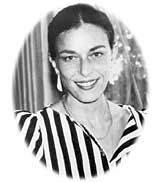
"Everything Jack created was larger than life," said Janet Berliner,
editor and collaborator on the 1979 manuscript. "His unfinished novel The
Horde was no exception. I was fascinated by its energy, its color, its characters.
It should come as absolutely no surprise that he created new sets of super-heroes
and super-villains, and that beneath the dynamic of a novel that set out to
depict the end of the world as we knew it, lay a complex philosophy."
Berliner first became involved with Jack and The Horde in the late 1970s. "I
was agenting, ghosting, editing, and writing my first novel. At some point,
I went to LA for a weekend. Ed Bryant and I were staying at Harlan [Ellison]'s
house. Somehow, Ed and I ended up visiting Roz and Jack. We saw his private
collection and watched him at work in his studio—an awesome experience."
Jack had written several versions of the manuscript at that point (dated 1970,
1972, 1976, and 1977), and not long after their first meeting, he contacted
Berliner and asked if she would agent his unfinished novel. "I felt that
the work needed discipline and crafting, that it was more like notes (or verbal
sketches) for a novel, but I agreed to send it out to a few editors to get initial
responses." Those responses confirmed Janet's reaction to the novel,
and Jack agreed to have her do major editing and rewriting.
The changes she made were extensive. "Artistic genius though he was, Jack
was not a writer. He had no idea of how to structure a novel, so I restructured
heavily. He also tended to write in undisciplined bursts of language which had
to be properly structured and toned down. In addition, I provided heavy doses
of transitions. Remember, this was a rough, unfinished novel by a man of genius.
I did everything with a view to maintaining his unique voice."
Berliner wrote a lengthy outline, redid the first few chapters, and put together
a pitch package to try to sell it to potential publishers. However, this was
Jack Kirby, who, for better or worse, had repeatedly refused to work with an
editor or co-writer on his comics work after parting ways with Stan Lee in 1970.
As a collaborator, Berliner did have to tread lightly: "I had to constantly
reassure him that The Horde was, always and ever, his baby. It was not initially
my role to rewrite the book; Jack wasn't yet ready for anyone to do that,
which has a lot to do with why I could not find a publisher at the time."
How did they physically work together on the project? "I reorganized Jack's
original manuscript, then started over at the beginning. I edited, rewrote,
sent the product to him, then we (often interminably) discussed the changes."
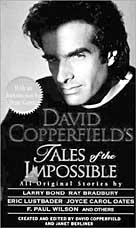 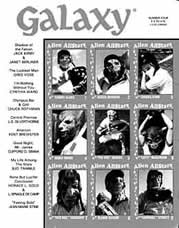
Many Kirby fans are aware of Horde excerpts that appeared in Galaxy Magazine
#4 (July/Aug. 1994) and the anthology book David Copperfield's Tales of
the Impossible (HarperPrism, November 1995). Both came about through Berliner's
efforts. A highly-regarded writer and editor, with numerous published short
stories already to her credit, Janet knew the ins and outs of getting work into
print.
"Those were not so much excerpts as extrapolations. I used his work as
a base, used his characters, but I had to provide stand-alone storylines. In
1993, Kurt Busiek and Lawrence Watt-Evans asked me to contribute a story to
an anthology they were editing for Bantam titled Behind The Mask. I contacted
Jack to ask if he'd like me to edit a piece from The Horde as a coauthorship
in hopes of awakening interest in the book." The story that resulted, "Eye
of the Falcon," never saw print because of an editorial change that caused
the cancellation of the Bantam anthology, but from that first sale, more extrapolations
followed. "Jack and Roz both loved what I was doing. He was so excited
by the prospect of some part of The Horde finally seeing print that he encouraged
me to cull another story, which became "Shadow of the Falcon" [Galaxy
#4]. The third story, "The Conversion of Tegujai Batir," [in David
Copperfield's Tales of the Impossible] came about a year-and-a-half later.
I created the Copperfield anthologies and suggested a Berliner-Kirby story to
David. Alas, Jack only saw one of them in print. Roz saw both." (Berliner
confirmed that magician David Copperfield was already aware of Kirby's
comics work when Janet approached him. "He knows a lot about art and admires
creative genius," she said.)
Although only Kirby's name appeared on the Copperfield story, Janet had
as much involvement on it as the other two. "Because I had to rewrite so
much of the material in order to round out the sections as short stories, I
received coauthor credit on the first two stories. For personal reasons, mostly
to do with the fact that I was the editor of the anthology and already had one
story in it, I took my name off the third story."
Berliner hoped to get The Horde before the public in other outlets, including
a full novel treatment, even film, but although those plans have yet to materialize,
her involvement with the work isn't over. The original story she culled
from Jack's manuscript, "Eye of the Falcon," is slated to appear
in an upcoming charity anthology by Steve Saville, with all proceeds going to
the Down's Syndrome Foundation. "The book is called Dreaming of Angels,
published by Prime, a new publisher in the US. The book is their debut title.
It will be available in mass-market paperback and deluxe hardcover editions,
and includes work from the likes of Michael Moorcock, Peter Crowther, and Ramsey
Campbell. The estate and I will each receive a copy in full payment."
In hindsight, Berliner still feels The Horde has potential commercial appeal.
"I'm as crazy about Jack's concept as I ever was. It was Jack,
always larger than life." On a personal level, Janet has very fond memories
of working with both Jack and Roz. She formed a close relationship with the
Kirbys, and distinctly recalls her last meeting with the couple. She had just
finished a project with novelist Michael Crichton, and decided to visit them
on a very stormy day in December, 1993—less than two months before Jack's
death. "Jack was very ill by then, but wanted to tell war stories. Roz
wanted him to conserve his energy, but there was no stopping him. When she realized
that, she produced coffee and homemade cookies. We sat in the kitchen listening
to Jack talk against the pounding of the elements on the roof and the windows.
I remember that he was particularly funny and that I cried and laughed and fell
in love with both of them all over again."
Enter: Ray Wyman & Peter Burke
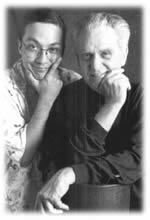 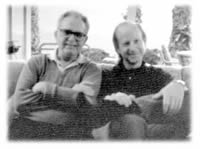
Writer Ray Wyman is best known to Kirby fans as author of The Art of Jack Kirby,
a biography published in the early 1990s. While working on that book, Ray's
conversations took a turn that would lead to his own involvement with The Horde.
Wyman recalls, "This particular tangent orbited about China—its history,
the population, and the future. I remember the conversation clearly; I have
part of it on a tape marked October 16, 1989. Jack had said some things that
reminded me of a book I had read years ago: Revolt of the Masses. It's
a collection of essays written by José Ortega y Gasset on qualities of
governing large populations, the nature of social dissension—social breakdown,
the 'mass-man' concept, and so on. It's not exactly a coffee
table book; it was compiled in 1932 and is read mostly by people involved in
political theory. So, you either learn about it in college (which is where I
heard of it) or somebody tells you about it. Jack had never heard of it; nevertheless,
some of his thinking for the story coincided Ortega's. The more that we
got into the conversation, the more I appreciated Jack's version."
Ray was aware of "The Closet," familiar to those who frequented the
Kirby home. The term actually referred to any of the many closets spread throughout
the house, filled to overflowing with memorabilia and art. The original manuscript
for The Horde was on the highest shelf in the big closet in Jack's studio.
"Roz had to enlist my help to drag it down. My first question was, 'Jack
wrote a novel?' My first reaction was, 'Boy, this is going to be great!'
But then I started thinking, 'Why wasn't it ever published?'"
After his first read of the manuscript, Ray saw why, in much the way Janet
Berliner did earlier. "Jack was a tremendous storyteller when it came to
comics, but a novelist he wasn't. He had a gifted way of looking at things
and describing them. His dialogue and character interaction, at times, was very
good, but he failed to link the scenes and the descriptions together in a cohesive
way. That's the challenge for anybody who has tried to write a novel: Eighty
thousand words (at least), and each one of them has to be entertaining while
maintaining the reader's interest in the story. Jack did a great job of
this for a dozen or so pages at a time, but 200 of them...."
Wyman and Kirby went on to talk a great deal about The Horde. "Jack felt
that the moment China lost central control of the population, there would be
such a terrible revolt that it would trigger the largest mass migration in world
history. That's the basis of the story, the core idea that inspired his
story. Can you imagine such a thing? Jack thought about renaming The Horde 'Epoch',
but I told him that the original title was far better. 'Epoch' doesn't
even come close to describing the mess that things would be if his vision ever
came to fruition."
Wyman heard firsthand of Kirby's nightmares about it coming true—that
certain aspects had come into being right before his eyes on the nightly news,
and he and Jack shared that point of view for the story. "Humanity is in
for a world of hurt; this story lays out only one of the hundreds of possible
scenarios," said Wyman.
Following the release of The Art of Jack Kirby, the Kirbys gave Ray the original
unedited manuscripts as thanks for his hard work on the biographical book. There
was talk of continuing work with Jack on The Horde, but he died shortly after
that. On a subsequent visit to see Roz, Wyman says she made him promise to complete
the story. "That got to me," said Wyman. "I mean, Roz and I had
some real heavy talks along the way—stuff about Jack, stuff about her,
stuff about this and that—but this one made me feel like God had kicked
my shoulder."
Soon after, he started work by researching Mongolian/Chinese history, Genghis
Khan, Mongolian religion, the Chinese political environment, Asian continental
ecology, and various scholarly works that deal with Ortega's "mass-man"
concepts. "I completed a new story outline (based upon Jack's original)
about a year later—that was mid-1995. I tried to retain the good parts
that Jack wrote—some of the characterizations and the action scenes that
were very nicely done. Jack had this habit of going on with the story, then
bouncing back to a different part of the story in a flashback. Some of it is
pretty tedious to read. Pretty soon I knew that I was going to need some help."
That help came in the Summer of 1996 as Ray convinced Peter Burke to sign on
as a co-writer. Burke was surprised by the offer, but once work began, he saw
he had a part to play in the process. "I see my role in this as a story
collaborator and screenwriter, since I came into it after Jack and, later, Ray,
had established the main threads of the story. I am proud to think that my contribution
story-wise (as collaborator) has added something to the overall project,"
added Burke, "but the big strokes really belong to Jack."
Both men contributed ideas to the overall story, but Burke feels Wyman brought
a special creativity to the project—sometimes to his chagrin. "Ray's
creative juices are always _flowing—he's mercurial in that respect—and
_his ideas were sound and certainly worthy of exploration. Yet, going along
invariably meant _a re-write—sometimes dumping many hours of work to follow
some new string of ideas. Luckily, they were good ideas.
"To be fair, we discuss everything—then let Jack's spirit choose
our path. We take turns feeling responsible to Jack and Roz, and to the story.
This project is like a living being—a final testament to Jack's creative
magic. We feel obligated to see to its completion, the way Jack originally envisioned
it." This naturally requires rereading the original manuscript for sections
they can adapt to new situations. "For instance, there's a key character
that Jack did a great job of characterizing," said Wyman, "especially
when things get intense in the story. We're using nearly all of the material
that Jack wrote for that character. Then there are the emotional settings, where
the scene itself was vague, but the emotion is riveting. So Peter and I took
to adapting those areas so they read better. This task is a bit daunting. We
have a digital copy of the original, so it's a bit easier to find things—just
scan text for certain words and phrases—but it doesn't help much when
we're trying to find a specific idea."
Interestingly, the first product of the pair's efforts isn't a finished
novel, but a nearly-completed screenplay—something that's more Burke's
purview as the duo's lead screenplay writer. "Blocking out scenes
for the screenplay gave the novel direction," said Burke, "but still
left Ray with plenty of room in which to stretch. Mind you, it's not my
intention to trivialize the novel, but the story just works better that way.
We've created some very cinematic moments in this story and I think they'll
be fantastic on screen." Still, Wyman plans to see The Horde published
as Kirby intended: In novel form. "My job is to keep record of all of the
different versions and to, hopefully, stitch together a novel after the screenplay
is completed. We didn't plan it that way, but Peter's screenplay captures
the story beats in a way that none of my outlines did very well. The screenplay
has become the outline for the novel."
Wyman and Burke have hopes to expand The Horde beyond a single book—possibly
to a trilogy—which leads to the question: Just how much of Jack's
original manuscript is a part of their newly modified version? Wyman was adamant:
"We are trying to save as much of Jack's work word-for-word as possible.
In the screenplay, this is not as critical, but for the novel, it is essential.
I have had to change my writing style to match Jack's to accomplish this
task convincingly. Peter keeps me on target—he calls it the 'manly
prose'. He slaps my hand every time I reach out for the Thesaurus. Jack
used some pretty terrific words in his original, but it's more 'presence'
than word usage. It's actually a very good exercise, and if I am successful,
we could see a complete manuscript that will have all the appearances of Jack
having written the whole thing."
Burke commented, "Ray and I may add another 400 pages or so to the completed
novel. Most of the changes we've made add believability and drama to the
story. In the end, all three of us will be equal collaborators of the finished
product. The only thing I worry about is doing the job so convincingly that
people won't recognize our contribution. We were just talking about the
writing style a few days ago and I remember thinking how remarkably agile Jack
was at describing certain actions and characterizations. He was very blunt and
economic—he didn't spend a lot of time dressing up the scene. That's
the way the entire story should be. Even in the screenplay—the dialogue
and the action scenes are all in Jack's style. Some of the scenes he never
wrote, but avid fans will recognize them as Jack's."
Ray and Peter hope, by the end of this year, to present the completed manuscript
of their version to the Kirby family, with ownership split three ways.
Analysis Of The Horde
The Horde has come a long way since Kirby began writing it in 1969, and diverged
in very different directions, depending on who the collaborator was at the time.
Janet Berliner, with Kirby's consent, took liberties to make the original
manuscript more marketable, and has had some success in getting it into print,
with a third story from it soon to be published. Time will tell if Peter Burke
and Ray Wyman will be as successful with their own variation on Jack's
original story (the duo has stated they are not attempting to remain faithful
to what Berliner has had published, however). Since no part of their version
of The Horde is ready for release, my own analysis of the work must be limited
to the 1979 Berliner-edited manuscript, and the corresponding extrapolations
in Galaxy and Tales of the Impossible.
In analyzing the actual wordsmithing, it's difficult to make a determination,
since this is a heavily edited version of Jack's original manuscript; but
the 1979 manuscript does have the Kirby "voice" to it. Jack's
tendency in comics to write oftimes clunky dialogue for his characters does
occasionally rears its head, but it's only a minor annoyance. The beauty
of this manuscript of The Horde is that pure dialogue is either largely among
Tegujai and his followers (where Jack's flair for dramatic dialogue rings
true), or is kept to a minimum. But it's the narration that really sings
(as was often the case in Kirby's comics work). Whether the work of Berliner
or Kirby (or both), descriptions of scenes and actions are quite eloquent, and
though there are moments when I found myself saying, "Waitaminnit..."
and searching back a few pages to make sense of a scene, overall it was an engrossing
read. When the manuscript ended abruptly at a climactic moment, an audible "awwww..."
came from my lips. Like the first part of a 1960s Fantastic Four continued story,
I truly wanted to see what would happen next.
Comparing the Galaxy and Tales of the Impossible stories to the 1979 manuscript,
the editing ranges from minor (occasional word or phrase changes) to more extreme
(rearranging sections and minor rewrites to help the excerpts stand alone),
but none went far enough to circumvent the original intent and direction of
the manuscript I read. However, the excerpts don't do the novel justice.
Without all the preliminary set-up, and background on the three principal characters,
it's tough to really understand what's going on.
In approaching this article, I must confess to an initial bias as a Kirby purist,
feeling that The Horde should be published in its original manuscript form,
as-is, completely unmodified—let's see what Jack wrote, warts and
all, I thought. That's changed, due to my encounters with Berliner, Wyman,
and Burke, whom I think genuinely feel their work will present Kirby's
novel in a more accessible form, while staying true to his intent. All of Jack's
collaborators over the years, from editors and inkers to colorists, have added
their own expertise to making Kirby's work shine on the printed page. While
I'll always probably prefer seeing "raw" Kirby—whether in
pencil or typewritten text—I'm ready to afford all parties the respect
of presenting their finished versions, and judge them on their own merits. Perhaps
later, a behind-the-scenes look at Kirby's original, unfinished manuscript
will be appropriate.
Likewise, we should be glad that, rather than have it collect dust in a closet,
The Horde has found new life after Jack's passing. Here was a man who almost
never erased, never redrew, always putting it down right on the page the first
time—but for his novel, he rewrote it at least four times before asking
for help with it. This is a project Kirby cared deeply about, and wanted to
see completed. In the same way Kirby had little concern over who would "finish"
his pencils in ink, there's no use worrying over _the fact that someone
other than Jack is finishing the book. After all, the Kirby concepts and characters
are there, and the blueprint was laid out—and like the antagonists in the
Foreword, The Horde is coming, and it can't be stopped.
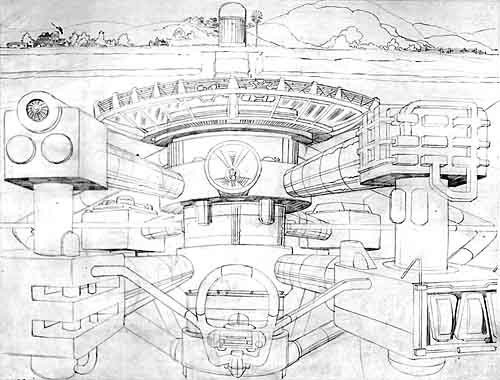
© The Estate of Jack Kirby.
All this talk of underground tunnels reminded us that we never ran the Tiger
21 info we promised back in TJKC #23. Shown here is Kirby's drawing of
the character's underground bunker complex, for a proposed 1960s television
show for NBC that never materialized. An agreement dated December 28, 1966 between
Jack, John Graham, and Lawrence K. Grossman stated there was a 2-page presentation
prepared, as well as additional artwork by Kirby. If we track it down, we'll
be sure to run it in TJKC.

Sign up here to receive periodic updates about what's going on in
the world of TwoMorrows Publishing.

Click here to download
our new Fall-Winter catalog (2mb PDF file)
|